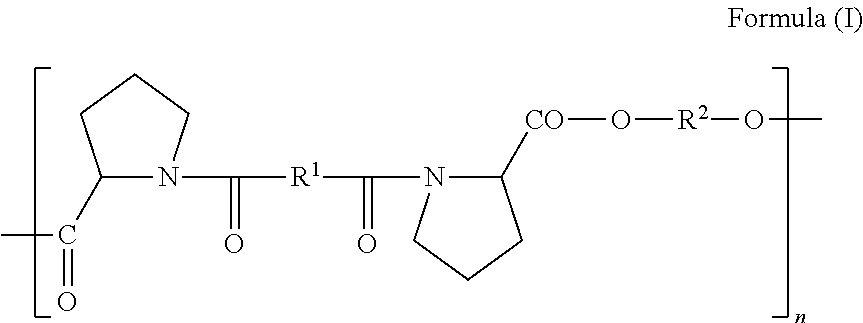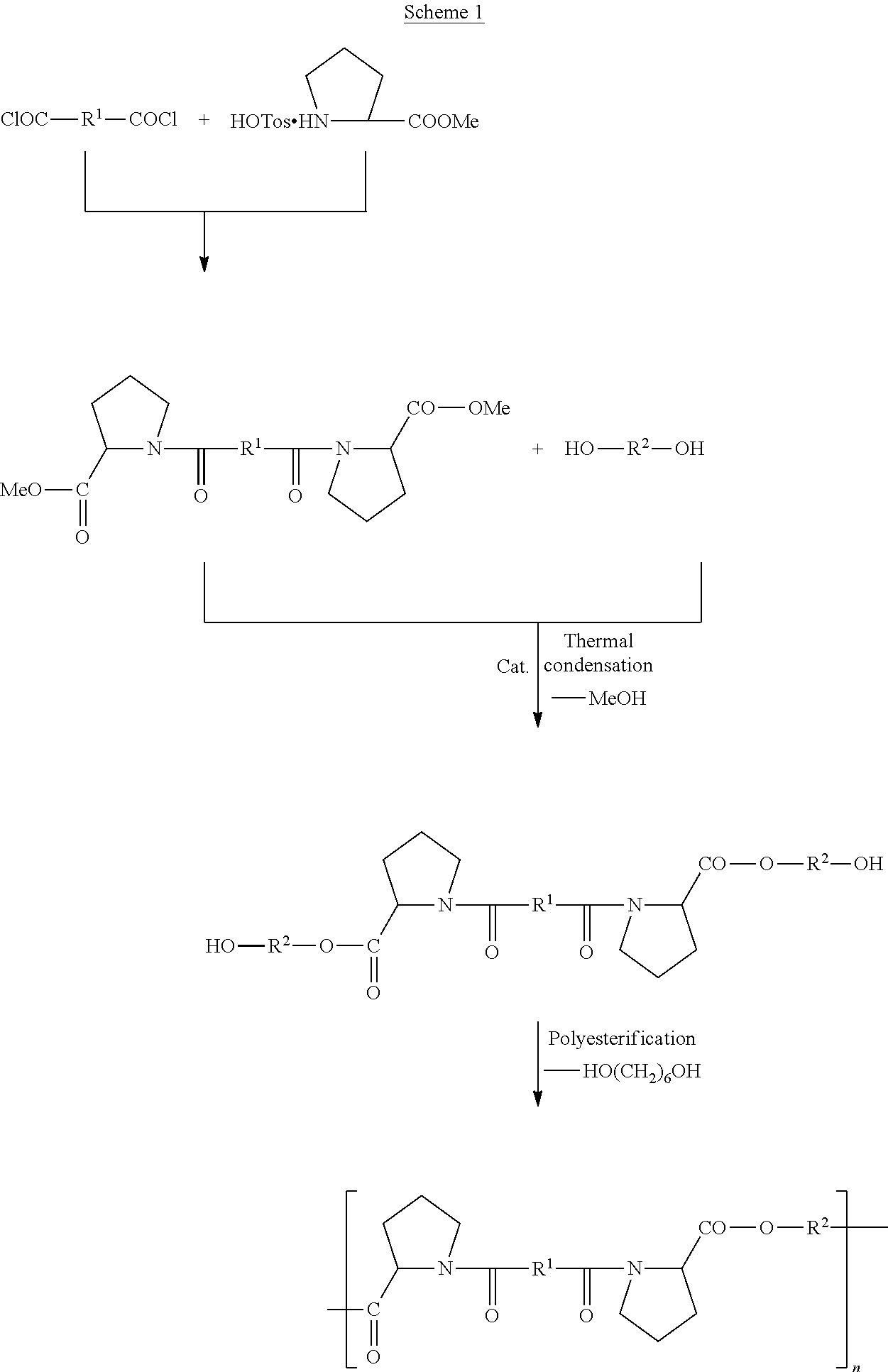Biodegradable Proline-Based Polymers
a proline-based polymer and biodegradable technology, applied in the field of biodegradable proline-based polymers, can solve the problems of decreased reactivity, difficult control and optimization of interfacial polycondensation, and difficulty in incorporating proline as the amino acid in the backbone of a pea polymer synthesized using the above-described methods, and achieves the effect of improving the behavior of aqueous solutions
- Summary
- Abstract
- Description
- Claims
- Application Information
AI Technical Summary
Benefits of technology
Problems solved by technology
Method used
Image
Examples
example 1
Product Characterization
[0038]The chemical structures of monomers and polymers were characterized by standard chemical methods; NMR spectra were recorded by a Bruker AMX-500 spectrometer (Numega R. Labs Inc. San Diego, Calif.) operating at 500 MHz for 1H NMR spectroscopy. Solvents CDCl3 or DMSO-d6 (Cambridge Isotope Laboratories, Inc., Andover, Mass.) were used with tetramethylsilane (TMS) as internal standard.
[0039]Melting points of synthesized monomers were determined on an automatic Mettler-Toledo FP62 Melting Point Apparatus (Columbus, Ohio). Thermal properties of synthesized monomers and polymers were characterized on differential scanning calorimeter (DSC) Mettler-Toledo DSC 822e. Samples were placed in aluminum pans. Measurements were carried out at a scanning rate of 10° C. / min under nitrogen flow.
[0040]The number and weight average molecular weights (Mw and Mn) and molecular weight distribution (Mw / Mn) of synthesized polymer was determined by Model 515 gel permeation chroma...
example 2
Synthesis of PEA 8-Pro(6) Polymers with Metal Chelator End Groups
[0058]Covalent attachment of metal chelating molecules to the hydroxyl end groups of invention polymer changes the binding capacity of the invention PEA polymer with various cations (e.g., Zn2+, Ni2+, Ca2+). These formulations with metal chelated end groups will bind to various biologics containing metal-binding amino acids, for example His-tagged proteins. The group of metal-chelating molecules can be used to end-cap the invention polymers include, for example, imidoacetic acid, for example: Ethylenediaminetetraacetic acid (EDTA), Diethylenetriaminepentaacetic acid (DTPA), and Ethylene glycol-bis(2-aminoethylether)-N,N,N′,N′-tetraacetic acid (EGTA).
[0059]EDTA binding to PEA 8-Pro(6) polymer was accomplished as illustrated in Scheme 3 below:
PEA 8-Pro(6)-EDTA (5 g scale): In 40 mL vial, 5.1 g of PEA 8-Pro(6) (Mw=28,000 Da) was dissolved in 15 mL NDN-dimethylformamide (DMF), under argon. Once dissolved, 49 ul (1 eq) TEA ...
example 3
Preparation of Docetaxel Nanoparticles
[0062]In 1.00 mL of ethanol, 4.29 mg of docetaxel and 10.0 mg of PEA-8-Pro(6), (Formula I, where (R1=(CH2)8 and R2=(CH2)6, n=110-160), were co-dissolved. The docetaxel / polymer solution was added slowly to 9.00 mL of a stirred aqueous buffer (in this case citrate, pH 7.0) containing 0.1% Bovine Serum Albumin (BSA), resulting in formation of nanoparticles by precipitation. The translucent dispersion of nanoparticles was transferred to regenerated cellulose dialysis tubing (MWCO 3500 Da) and dialyzed against aqueous buffer (100×v / v) at room temperature for 16 h to remove residual ethanol. The typical diameter of the docetaxel / polymer particles was 200-240 nm (PDI<0.15) with a zeta potential of −17 to −21 mV (determined on Malvern Zetasizer). A control formulation in which the invention PEA polymer was omitted during fabrication of particles, yielded only micron-scale crystals.
[0063]After processing, 77% of the docetaxel and 70% of the polymer were ...
PUM
| Property | Measurement | Unit |
|---|---|---|
| Temperature | aaaaa | aaaaa |
| Temperature | aaaaa | aaaaa |
| Percent by mass | aaaaa | aaaaa |
Abstract
Description
Claims
Application Information
 Login to View More
Login to View More - R&D
- Intellectual Property
- Life Sciences
- Materials
- Tech Scout
- Unparalleled Data Quality
- Higher Quality Content
- 60% Fewer Hallucinations
Browse by: Latest US Patents, China's latest patents, Technical Efficacy Thesaurus, Application Domain, Technology Topic, Popular Technical Reports.
© 2025 PatSnap. All rights reserved.Legal|Privacy policy|Modern Slavery Act Transparency Statement|Sitemap|About US| Contact US: help@patsnap.com



